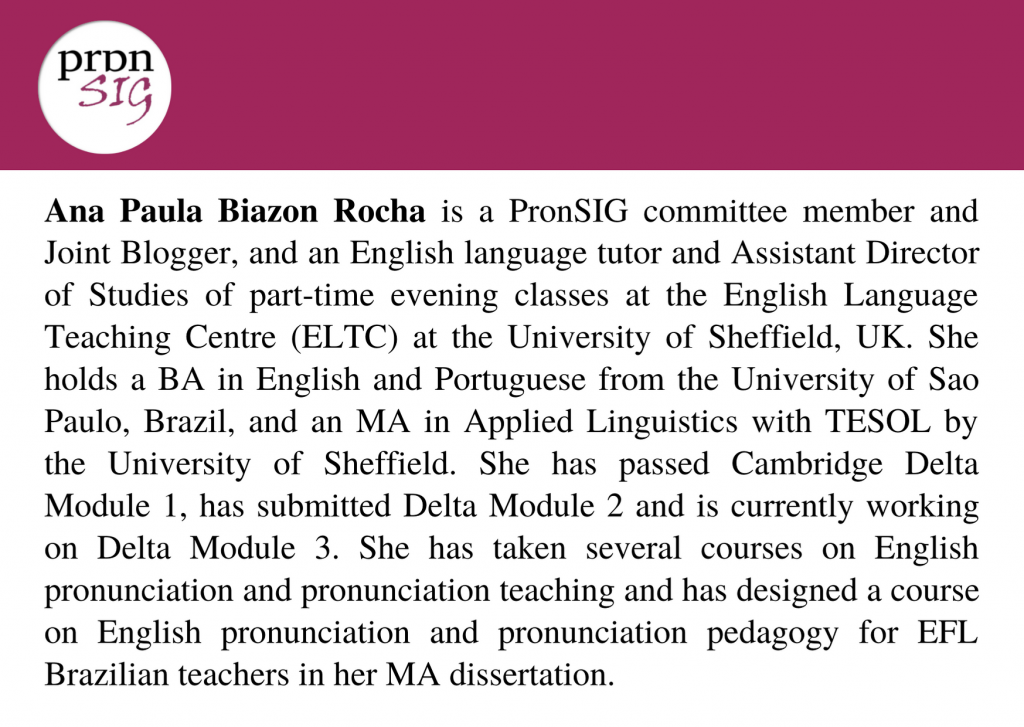by Ana Paula Biazon Rocha
The most conventional approach to pronunciation teaching is listen and repeat, where teachers provide learners with a model, such as their own, an audio track, a video, etc., and have students repeat after it. However, in the last decades, the efficacy of such an approach has been questioned. In this post, we will discuss different ways through which listen and repeat can be enhanced in class when we teach pronunciation.
Rooted in behaviourism and in the audiolingual method, drills and choral repetition are based on students being able to imitate what they hear, and then repeat as a way to aid memory and develop a physical habit (Celce-Murcia et al., 2010; Underhill, 2019). Despite the contrary opinions regarding these pronunciation practices, the fact that most of the pronunciation work in English lessons tends to be solely based on them, with minimal or no variation, and in many cases, in a decontextualized way (Jones,1997), is a matter of serious concern. Listening and repeating only for the sake of it do not necessarily mean that students are learning and improving their pronunciation.
Consequently, within listen and repeat, as one of the steps of pronunciation practice in our lessons, there should be ‘smart repetition where each repetition learns from and is changed by the one before’ (Underhill, 2019). That is, students should not repeat things passively and mechanically but actively and meaningfully, focusing on how they hear and produce sounds and how they can improve that, learning from such a repetition.
Thus, based on Underhill’s (2019) concept of ‘smart repetition’, here are some tips to help teachers and learners make the most of listen and repeat:
1. Make sure students understand the meaning of the word/phrase/sentence they are going to listen and repeat. If you ask them to listen and repeat something they do not know, their attention will be primarily directed to guessing meaning rather than focusing on the sounds, and then the pronunciation practice will be wasted (Walker, 2019).
2. Instead of having learners repeat right after you, ask them to listen first and let what they have heard reverberate in their ‘mind’s ears’ (Underhill, 2005). Ask them to pay attention to the way you articulate the sounds, how your lips, tongue and jaw move. You can repeat the word again once or twice, but students should still just listen. Then ask them to repeat. In this way, we give students time to process the sounds and create a sound memory rather than having them immediately repeat something that their brains have not even recognised yet (Underhill, 2005, 2019; Walker, 2019). Click on the video below to see a demonstration.
3. Ask all students to repeat first rather than having individual ones repeat right after you, which avoids putting learners on the spot (Kelly, 2000). Their attention should be focused on the sounds, not on the stress of being exposed in front of the class.
4. If you are teaching face-to-face, after having the choral repetition, don’t say the name of individual students. Just point to each of them (in a friendly way, of course!), so the sounds are still reverberating in students’ ‘mind’s ears’ (Underhill, 2005), and are not interrupted by other sounds (the learner’s name). If you are teaching online, type the name of the student(s) in the chat box, but don’t forget to explain what they should do before starting the repetition practice, otherwise they will get lost!
5. In choral repetition, vary the patterns: louder, lower, fast, slow, angry, happy, sad, surprised, etc. You are making learners experiment with the sounds, it is quite fun and we avoid boring and meaningless repetition.
6. When you notice that a particular student is doing well with the target sound/word, let them be the model instead of you. Tell the learner why you are ‘giving them the lead’, as in praising them and then asking them to model the utterance. They pronounce first and then everybody repeats including you. You can also have one group pronounce and the other group repeat and vice-versa (Hancock, 2020).
7. If you are drilling a word or phrase, have students also listen and repeat sentences with it. You can use everyday examples or even use students’ names in the sentences (Yoshida, 2016). When drilling the sentence, make learners pay attention to connected speech, so we can enhance their perception of sounds in the stream of speech, not sounds in isolation.
8. Finally, don’t spend too much time on drilling and choral repetition (Yoshida, 2016), they are a part of the pronunciation work in class, not the only work. Have learners use the sounds in meaningful communicative activities, such as role-plays, discussions, problem-solving tasks, etc., which can help improve their perception and production of the language in real-life communication (Jones, 1997).
Changing old habits is never easy, but if you incorporate the tips above into your lessons little by little, it will eventually become more natural to you and your learners. So, I do hope you give them a try!
Don’t forget to follow PronSIG on social media and leave your comments below.
References
Celce-Murcia, M., Brinton, D., & Goodwin, J., with Griner, B. (2010). Teaching Pronunciation: A Course Book and Reference Guide (Second Edition). New York, NY: Cambridge University Press.
Hancock, M. (2020). 50 Tips for Teaching Pronunciation. Cambridge: Cambridge University Press.
Jones, R. H. (1997). ‘Beyond ‘Listen and Repeat’: Pronunciation Teaching Materials and Theories of Second Language Acquisition’, System, 25 (1),
p. 103-112.
Kelly, G. (2000). How to Teach Pronunciation. Harlow: Pearson.
Underhill, A. (2005). Sound Foundations (Second Edition). Macmillan Books for Teachers. London: Macmillan.
Underhill, A. (2019). My Top Ten Pronunciation Tips: Physicality and Integration. Available at: https://www.oxfordtefl.com/blog/my-top-ten-pronunciation-tips-physicality-and-integration-by-adrian-underhill . Accessed on 07 March 2020.
Walker, R. (2019). Pronunciation Teaching Basics. IATEFL PronSIG Event, Glasgow: University of Strathclyde. Slides available at: https://pronsig.iatefl.org/wp-content/uploads/2019/Glasgow2019/Walker-Glasgow-2019.pdf.
Yoshida, M. T. (2016). Beyond Repeat After Me. Teaching Pronunciation to English Learners. TESOL Press.



Great tips, Ana.